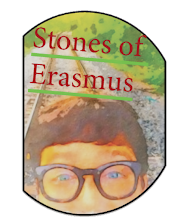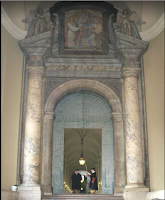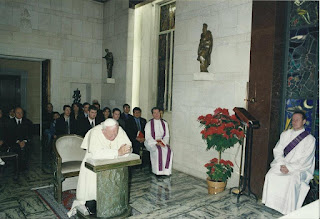 |
| The author sits astride the entrance to an ancient Roman snack shop on what was once a busy commercial street in Ostia, Antica. |
Hi, I’m Greig — welcome! Here you’ll find sharp writing, creative ideas, and standout resources for teaching, thinking, making, and dreaming in the middle and high school ELA and Humanities classroom (Grades 6–12).
20.12.24
Travel Diary: Ancient Roman Port Town of Ostia Antica on a Summer Day in 2004
 I am an educator and a writer. I was born in Louisiana and I now live in the Big Apple. My heart beats to the rhythm of "Ain't No Place to Pee on Mardi Gras Day". My style is of the hot sauce variety. I love philosophy sprinkles and a hot cup of café au lait.
I am an educator and a writer. I was born in Louisiana and I now live in the Big Apple. My heart beats to the rhythm of "Ain't No Place to Pee on Mardi Gras Day". My style is of the hot sauce variety. I love philosophy sprinkles and a hot cup of café au lait.
16.7.23
A Marvel in Marble: The Angel Relief Sculpture by Antonio Rizzo at The Metropolitan Museum of Art
 |
| Angel Holding a Shield, Antonio Rizzo, Italian, 1470 |
 I am an educator and a writer. I was born in Louisiana and I now live in the Big Apple. My heart beats to the rhythm of "Ain't No Place to Pee on Mardi Gras Day". My style is of the hot sauce variety. I love philosophy sprinkles and a hot cup of café au lait.
I am an educator and a writer. I was born in Louisiana and I now live in the Big Apple. My heart beats to the rhythm of "Ain't No Place to Pee on Mardi Gras Day". My style is of the hot sauce variety. I love philosophy sprinkles and a hot cup of café au lait.
11.12.22
Grandson and Grandfather: Birthday Portrait
 |
| A one-year-old and his ninety-nine-and-a-half year old grandfather |
I like comparing and contrasting, juxtaposing, and setting images side by side. When @seefuego’s son, the birthday boy, smiled at his ninety-nine-and-a-half-year-old grandfather, I quickly snapped the picture. Noah just turned one. His grandfather, an immigrant from the South of Italy, will turn one hundred soon. He told me he had fought during World War Two, stationed on an island in Guam. When the Americans dropped two atomic bombs on Japan — he told me, “The war was over, but it took me five months to get home. Once the transport ship arrived in Los Angeles, I had to fly home [back to New York].” He also spoke about being an Italian kid — “Growing up, I spoke a dialect of Italian, and I did not know English well. But in school, I was forbidden from speaking Italian. And I had to stand in the back of the classroom. I thought fighting in the war would prove my service to my country. So I joined the war effort. I was young.” It was remarkable hearing his story — and listening to him as Noah, his grandchild, frolicked in a space suit — his obsession. And by coincidence — his birthday coincides with the @nasa Artemis moon mission — an uncrewed spacecraft that safely returned to Earth today.
 I am an educator and a writer. I was born in Louisiana and I now live in the Big Apple. My heart beats to the rhythm of "Ain't No Place to Pee on Mardi Gras Day". My style is of the hot sauce variety. I love philosophy sprinkles and a hot cup of café au lait.
I am an educator and a writer. I was born in Louisiana and I now live in the Big Apple. My heart beats to the rhythm of "Ain't No Place to Pee on Mardi Gras Day". My style is of the hot sauce variety. I love philosophy sprinkles and a hot cup of café au lait.
25.10.20
On How To Meet a Pontiff (Or, That Day I Attended a Private Audience with John Paul II)

|
|
When I was a Roman Catholic Seminarian, and the very young age of nineteen, I was in a private audience with the then Pontiff of the Roman Catholic Church, John Paul II |
To say that I met and chatted with the leader of the Roman Catholic Church would be a stretch. But I did kiss his ring. And I got to see him in his private chapel and in his private library in the Vatican.
I attended a private audience with about twenty-five other people — mostly priests and seminarians. It was the year 2000—around Christmas time—and I was in Rome with other American seminarians from the American College in Leuven, Belgium (where I was a college seminarian at the Catholic University of Leuven). At the time I was studying to be a priest, and our group was invited to have a private audience. The story went that when John Paul II was a seminarian in Krakow, Poland, his seminary was suppressed by the Nazis and apparently, the American College, in Leuven, had sent over, secretly, supplies, books, and the sort, to Poland, as a sign of support and solidarity.
We were in Rome for two weeks, staying as guests at the Pontifical North American College (located on the Janiculum hill) — but we didn't know what day our audience would happen. There are security protocols one follows when scheduled to meet the Pope. The Vatican gave a call to our group leader, a Benedictine priest named Aurelius Boberek, the night before and he then contacted us to be on the ready. We're meeting the pope!

|
| The Bronze Doors |
The night I heard the message I had to scrap my plans for the following day. I was planning to visit the catacombs of Saint Callistus. Oh well, I thought, a papal visit trumps all of that. So we had to wake up early — to arrive at the Bronze doors of the Vatican Apostolic Palace at the crack of dawn. You enter the doors from the right colonnade in Saint Peter's Square. Once we were green-lit to proceed, we were inside the Apostolic Palace — which extends as a grand loggia, designed by the Renaissance artist Raphael. It serves as an official portal and links up with the jumble of buildings that comprise the palace.
John Paul II had a private chapel in the papal apartments, located in the upper floors of what is officially called the Palace of Sixtus V, where he celebrated an early mass. It was so quiet when we arrived one could hear a pin drop. The Pope enters the sanctuary fully vested and he celebrated the Mass in the old Latin rite style — facing the altar (and not facing the people). I think I read one of the readings for the Mass (Or, maybe I read the intercessions. I cannot remember, exactly). So did my classmate Brent Necaise, who was a student with me — I was from Louisiana and he was from Mississippi). Afterward, the Pope's private secretary, a fellow by the name of Stanislaus Dziwisz, escorted us to the private study (or was it the library?) of the Pope.
It was Christmas time, so in the Pope's library there was a stately Christmas tree with ornaments painted with images of John Paul II. I remember thinking that was funny for some reason. I guess if you are Pope you get used to seeing your image affixed to everything from postage stamps, money, and ornaments. I remember all of the furniture was elegant but not overstated. It was a brightly lit room. And there was a wooden barrister bookcase with nicely appointed leather-bound books.
The Pope entered shortly after we had congregated and took a seat in a white plush chair. Everyone in our group lined up to meet him one by one, by kissing his ring, and stating our home state in the United States. When it was my turn he said softly, "Oh. The Mardi Gras," because it was announced I was a seminarian from Louisiana, and when another seminarian said he was from Kentucky he said, "Oh. Race horses." And it went like that — and each of us received a rosary and a holy card.
 |
 I am an educator and a writer. I was born in Louisiana and I now live in the Big Apple. My heart beats to the rhythm of "Ain't No Place to Pee on Mardi Gras Day". My style is of the hot sauce variety. I love philosophy sprinkles and a hot cup of café au lait.
I am an educator and a writer. I was born in Louisiana and I now live in the Big Apple. My heart beats to the rhythm of "Ain't No Place to Pee on Mardi Gras Day". My style is of the hot sauce variety. I love philosophy sprinkles and a hot cup of café au lait.
15.5.19
Family History: My Mother’s Doctor is a Roselli
 |
| Mom with Dr. Eric Roselli at the Cleveland Clinic |
Mom had a hunch; there was a connection with this particular Roselli because she told me she had a feeling he was related. She said, ”So when I asked him to tell his story he said his grandfather Ercole (Hercules in Italian) emigrated from Italy and he had had a brother named Joseph.” Mom said her eyes lit up. My grandfather, Joseph, emigrated from Italy in 1923. He had a brother named Ercole. They were separated after my grandfather came to the United States after the death of his mother and they didn’t see each other for decades until they were finally reunited as adults. The stories matched! My grandfather, when he emigrated, lived in Detroit. He was a young man, and eventually, he moved to Louisiana. Ercole finally settled in Detroit too and stayed there. So if both stories corroborate - my father and Dr. Roselli are first cousins.
Dr. Roselli’s father is my father’s uncle. We both share a common paternal grandfather. And this Dr. Roselli will take care of my mom (who is a Roselli by marriage). Mom kept the surname even after she divorced my father twenty-five years ago. I guess she liked the name! And she was raising my two brothers and me, so it made it more comfortable when she was dealing with stuff related to us kids. She never changed the name. So this story is really about my mom who is a cancer survivor, and now she’s battling this recent inflammation of her artery. She’ll have surgery done, and the chances are good she’ll come out of it with a clean bill of health. You've got the Roselli’s on your side!
I've written about family history on my blog - check out related articles here.
 I am an educator and a writer. I was born in Louisiana and I now live in the Big Apple. My heart beats to the rhythm of "Ain't No Place to Pee on Mardi Gras Day". My style is of the hot sauce variety. I love philosophy sprinkles and a hot cup of café au lait.
I am an educator and a writer. I was born in Louisiana and I now live in the Big Apple. My heart beats to the rhythm of "Ain't No Place to Pee on Mardi Gras Day". My style is of the hot sauce variety. I love philosophy sprinkles and a hot cup of café au lait.
29.4.11
Travel Diary: Fountain Lover, 2007
 |
| Roma, Italia |
 I am an educator and a writer. I was born in Louisiana and I now live in the Big Apple. My heart beats to the rhythm of "Ain't No Place to Pee on Mardi Gras Day". My style is of the hot sauce variety. I love philosophy sprinkles and a hot cup of café au lait.
I am an educator and a writer. I was born in Louisiana and I now live in the Big Apple. My heart beats to the rhythm of "Ain't No Place to Pee on Mardi Gras Day". My style is of the hot sauce variety. I love philosophy sprinkles and a hot cup of café au lait.
25.11.10
Cinema Paradiso: The Best Ending in a Film
The score by Ennio Morricone is the most moving cinematic piece ever produced for the silver screen. The music is deliberately made to induce emotions, and I think it adds to this movie's overall sympathetic tone.
Second, There is the Film's Meta-ending
To fully appreciate the ending, one has to watch the entire movie. The last scene is a kind-of-love-letter to cinema itself. As a boy, the protagonist, Totò, befriends his hometown's cinema projectionist, Alfredo. In this small skirt of a town in rural Italy, the Catholic Church has considerable sway over what her parishioners can watch at the local cinema. The parish priest personally censors the films on view and directs Alfredo to edit out any scenes that depict kissing. At the end of the movie, Alfredo, who has since died, and Totò, who has become a famous movie director, there is a discovery. Can you guess what it is? The discovery becomes the movie's final scene. And it brought me to tears. If there is such a thing as poignancy without sentimentality, it's this film.
 I am an educator and a writer. I was born in Louisiana and I now live in the Big Apple. My heart beats to the rhythm of "Ain't No Place to Pee on Mardi Gras Day". My style is of the hot sauce variety. I love philosophy sprinkles and a hot cup of café au lait.
I am an educator and a writer. I was born in Louisiana and I now live in the Big Apple. My heart beats to the rhythm of "Ain't No Place to Pee on Mardi Gras Day". My style is of the hot sauce variety. I love philosophy sprinkles and a hot cup of café au lait.
15.8.10
Salo: A Film You Really Don't Need To See
Learn about the Pasolini film Salò. It's another film I add to my list of films I cannot stomach to watch completely.
 |
| Salò, or the 120 Days of Sodom, Directed by Pier Paolo Pasolini (1975) |
The film documents horrific events masterminded by members of Italy's fascist elite during the Second World War. An oligarchic assembly chooses from the most beautiful youth in the surrounding towns and rural areas to systematically torture and destroy. The message is blunt. Given enough prestige and power, people will live out their cruelest nihilistic fantasies if given the opportunity.
 I am an educator and a writer. I was born in Louisiana and I now live in the Big Apple. My heart beats to the rhythm of "Ain't No Place to Pee on Mardi Gras Day". My style is of the hot sauce variety. I love philosophy sprinkles and a hot cup of café au lait.
I am an educator and a writer. I was born in Louisiana and I now live in the Big Apple. My heart beats to the rhythm of "Ain't No Place to Pee on Mardi Gras Day". My style is of the hot sauce variety. I love philosophy sprinkles and a hot cup of café au lait.
24.3.10
Photograph: Swiss Guards
| Swiss Guards Standing Guard near the Cancello Petriano in the Vatican City. The Paul VI Audience Hall is visible in the right background. The Teutonic cemetery is also visible straight ahead and to the right is part of the Colonnade of Saint Peter's Square. (Image Credit © 2007 Greig Roselli) |
 I am an educator and a writer. I was born in Louisiana and I now live in the Big Apple. My heart beats to the rhythm of "Ain't No Place to Pee on Mardi Gras Day". My style is of the hot sauce variety. I love philosophy sprinkles and a hot cup of café au lait.
I am an educator and a writer. I was born in Louisiana and I now live in the Big Apple. My heart beats to the rhythm of "Ain't No Place to Pee on Mardi Gras Day". My style is of the hot sauce variety. I love philosophy sprinkles and a hot cup of café au lait.
